The National Program to Eliminate Diabetes Related Disparities in Vulnerable Populations
 Purpose
Purpose
The National Program to Eliminate Diabetes-Related Disparities in Vulnerable Populations (“Vulnerable Populations,” hereafter) was a five-year cooperative agreement (2010-2015). The main goal of the agreement was to identify and carry out public health activities specific to the culture of selected communities to address differences in health outcomes associated with diabetes. These activities aimed to:
- Prevent and control factors that increase the risk for developing Type 2 diabetes and its complications, such as poor nutrition and physical inactivity.
- Raise diabetes awareness.
- Promote diabetes self-management.
- Improve outcomes and quality of life for those living with diabetes in high-risk communities and regions across the country.
 How is CDC Working to Reduce Diabetes-related Disparities in Communities?
How is CDC Working to Reduce Diabetes-related Disparities in Communities?
Differences in type 2 diabetes rates are noted across underserved communities in various areas of the country due to complex individual, social, cultural, economic, and environmental factors. To address these issues, CDC funded and supported six national organizations to engage and work with local partners in 18 communities by:
- Establishing partnerships and coalitions.
- Building capacity.
- Conducting community needs assessments.
- Developing community action plans.
- Identifying and implementing culturally-tailored, evidence-based interventions.
- Evaluating interventions implemented in the communities.
- Sharing lessons learned and findings about effective strategies.
National organization awardees
- Association of American Indian Physicians (AAIP)
- Association of Asian Pacific Community Health Organizations (AAPCHO)
- Kentuckiana Regional Planning and Development Agency (KIPDA)
- National Alliance for Hispanic Health (NAHH)
- National Kidney Foundation of Michigan (NKFM)
- The Center for Appalachian Philanthropy (AppaPhil)
Mouse over the territories to see their descriptions.
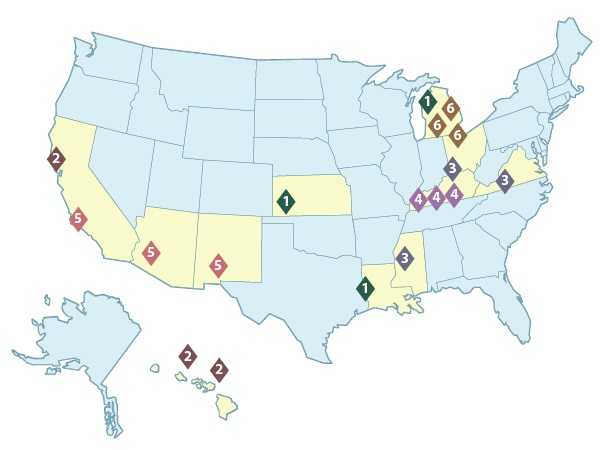
Click here to see the text description of the above map
How are Communities Taking Action to Address Diabetes?
The Vulnerable Populations awardees worked with local partners to make diabetes easier to prevent, manage and control. To improve health and wellness in communities across the country, awardees focused on the following:
- Increased access to healthy food options
- Increased access to safe and low cost physical activity
- Increased access to diabetes self-management education
- Increased diabetes education and awareness
- Increased policies that promote changes in the environment (i.e. walking paths)and systems (i.e. diabetes self-management education through health clinics)
Program and CDC partners are pleased to share observations, lessons learned, and a growing bank of stories.
Communities in Action Profiles (CAPs) provide a brief overview of how national organization awardees worked with local partners to identify and address diabetes-related issues in target communities.
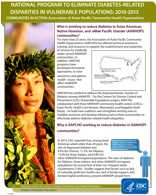 Food Matters
Food Matters
Healthy eating is one of the most important factors in helping to control and manage Type 2 diabetes. However, in certain communities, the availability of fresh, healthy and affordable foods is limited. The lack of access contributes to a poor diet and can lead to higher levels of obesity and other diet-related diseases, such as diabetes. On the island of Ebeye, in the Republic of the Marshall Islands, the rocky sand and soil make it difficult to grow food and provide healthy eating options. These conditions are believed to contribute to the high rates of diabetes among its residents. To address this issue, the Association of Asian Pacific Community Health Organizations, the Kwajalein Diabetes Coalition and other local partners trained community members to use garden boxes to grow fresh produce. Read more about AAPCHO’s work with partners in the Pacific Islands and other communities.
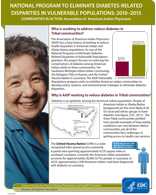 Making it easier to be Physically Active
Making it easier to be Physically Active
When people don’t get enough physical activity, this can lead to obesity. However, if they get enough physical activity, this can help them lower the chances of becoming obese and manage their type 2 diabetes. Living near places that support physical activity increases the likeliness of regularly getting exercise. Individuals living in vulnerable communities may have less access to low-cost facilities for physical activity. In an effort to curb rates of diabetes among members of the Kickapoo Tribe in Kansas, the Association of American Indian Physicians (AAIP), led by the Kickapoo Diabetes Coalition which conducted a community needs assessment, began to look at ways to increase physical activity among community members. The tribe had access to vast amounts of land but no safe place to walk. The Kickapoo Diabetes Coalition developed a community action plan. AAIP partnered with a local foundation to design and build a half-mile walking trail – the first on the reservation. Read more about the AAIP’s work with partners in Kansas and other Native communities.
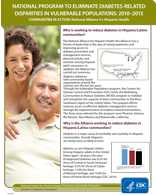 Supporting Peers through Diabetes Self-Management Education
Supporting Peers through Diabetes Self-Management Education
Diabetes Self-Management Education (DSME) is an important part of care for people with diabetes. Despite evidence that DSME is an effective strategy for people with type 2 diabetes, participation in DSME classes continues to be low in certain populations. People with diabetes often do not receive DSME, despite living in communities in which programs are offered. The engagement of Community Health Workers or promotoras has been a successful way to link people with diabetes with DSME and other resources. This approach has been effective in Hispanic/Latino communities where participation to DSME is often limited. The National Alliance on Hispanic Health (NAHH) worked with local partners in Phoenix, AZ, Rio Rancho, NM and Watsonville, CA to train Community Health Workers to facilitate DSME programs using materials for Spanish-speaking people with diabetes. Read more about the NAHH’s work to build capacity for DSME in the selected communities.
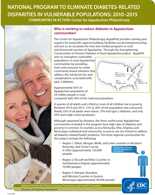 Increasing Diabetes Awareness in Appalachia
Increasing Diabetes Awareness in Appalachia
Those living in rural areas of Appalachia have additional challenges when it comes to diabetes and its management. The number of people with diabetes in the Appalachian region continues to grow at an alarming rate. The culture of the Appalachian region plays a significant role in beliefs about diabetes, level of diabetes awareness and how diabetes care is received. Lack of knowledge about how to work effectively with Appalachian communities has been proposed as a barrier for healthcare providers and others wanting to deliver diabetes services in this region. To focus on this issue, the Center for Appalachian Philanthropy (AppaPhil) established the Faith-based Linkages for Health initiative in several counties. The program works with local church leaders to address the wellness needs of congregation members through a health assessment, the creation of church health teams and linkages to health resources. Read more about AppaPhil’s work in counties across Appalachia.
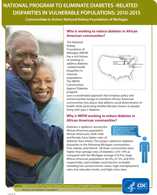 Partners in Policymaking for Physical Activity
Partners in Policymaking for Physical Activity
In many communities there are opportunities to create or enhance facilities for physical activity in public places like schools, community centers, malls and parks. Free or reduced cost opportunities may encourage those who are the least likely to be active to take advantage of these resources. In Flint, MI, National Kidney Foundation of Michigan (NKFM) and members of the Flint Better Health Together coalition worked with the City of Flint to adopt a Complete Streets policy. The policy supports street designs that enable safe access for all users, including people who walk, bicyclists, motorists, and transit riders of all ages and physical abilities. NKFM collaborated with many local partners to increase policies that support environmental changes to promote increased physical activity in Inkster, Flint, and Detroit in Michigan. Read more about NKFM’s work with partners in Michigan.
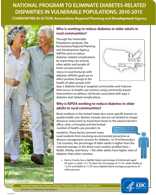 Partners in Policymaking for Diabetes Education
Partners in Policymaking for Diabetes Education
People with diabetes living in rural communities are less likely to access to health care services and resources and, as a result, experience poorer health outcomes. Diabetes education and information is not often readily available to individuals in rural communities and this creates difficulties in the care of people with diabetes, particularly in communities where the closest health care system or provider may be miles away. The Kentuckiana Regional Planning and Development Agency (KIPDA) established the KIPDA Rural Diabetes Coalition (KRDC), a tri-county regional group to improve the health of people with type 2 diabetes in Bullitt, Shelby, and Henry counties in Kentucky. The KRDC, along with the Kentucky Diabetes Network, trained local community advocates to effectively communicate to their policymakers about the importance of diabetes education. Read more about KIPDA’s work with partners across these rural counties.
Making the Connection: Engaging Community Partners to Address Type 2 Diabetes in Vulnerable Populations
 This collection of stories shows how Vulnerable Populations awardees, local organizations and other stakeholders worked together. The work focused on diabetes-related issues through outreach activities at the individual, family, community, and policy levels. The stories highlight strategies used to address risk factors associated with diabetes such as:
This collection of stories shows how Vulnerable Populations awardees, local organizations and other stakeholders worked together. The work focused on diabetes-related issues through outreach activities at the individual, family, community, and policy levels. The stories highlight strategies used to address risk factors associated with diabetes such as:
- Poor nutrition.
- Physical inactivity.
- Lack of diabetes awareness.
- Limited culturally tailored diabetes self-management education.
- Lack of diabetes support and resources in their targeted communities.
Additionally, the stories address how the activities affected people living with diabetes in the targeted program communities, and how promising efforts will be sustained. Read more about Making the Connection: Engaging Community Partners to Address Type 2 Diabetes in Vulnerable Populations.
- Page last reviewed: April 6, 2016
- Page last updated: April 6, 2016
- Content source:
- Maintained By:
- National Center for Chronic Disease Prevention and Health Promotion, Division of Diabetes Translation


 ShareCompartir
ShareCompartir